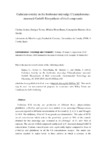Cadmium toxicity on the freshwater microalga Chlamydomonas moewusii Gerloff: Biosynthesis of thiol compounds

View/
Use this link to cite
http://hdl.handle.net/2183/16985Collections
- Investigación (FCIE) [1228]
Metadata
Show full item recordTitle
Cadmium toxicity on the freshwater microalga Chlamydomonas moewusii Gerloff: Biosynthesis of thiol compoundsDate
2010-09Citation
Suárez, C., Torres, E., Pérez-Rama, M., Herrero, C. and Abalde, J. (2010), Cadmium toxicity on the freshwater microalga Chlamydomonas moewusii Gerloff: Biosynthesis of thiol compounds. Environmental Toxicology and Chemistry, 29: 2009–2015. doi:10.1002/etc.242
Abstract
Cadmium (Cd) toxicity and production of different thiols (phytochelatins, glutathione, γ-Glu-Cys and cysteine) were studied in the microalga Chlamydomonas moewusii exposed to different concentrations of this metal (1, 2, 4, 6, 8, and 10 mg/L) for 96 h. The inhibitory effect of Cd on growth was demonstrated. The value of EC50 (metal concentration which reduces the population growth to 50% of the control) obtained for this microalga was estimated at 4.1 ± 0.8 mg/L of Cd after 96 h of exposure. The amount of thiol compounds synthesized by C. moewusii changed with Cd concentration. Cysteine concentrations were significantly higher compared to those of γ-Glu-Cys and glutathione in all the Cd concentrations assayed. The amino acid cysteine reached its higher levels in those cultures in which a decrease in the concentration of phytochelatins (PCs) was observed. Both cysteine and glutathione concentrations showed significant differences along the Cd concentrations assayed, while the amount of γ-Glu-Cys detected remained stable. The PCs detected were of two, three, and four subunits. The level of PC2 was higher than that of PC3 and PC4. PC4 was detected only in the cultures exposed to the Cd concentrations of 1 and 2 mg/L, in which the synthesis of phytochelatins was higher. A rapid increase in the production of PC2 and PC3 was observed up to a Cd concentration of 2 mg/L, after which their levels began to decrease. Phytochelatins were not detected in cultures without Cd (controls) and in those exposed to the maximum Cd concentration (10 mg/L), in which cell growth was completely inhibited
Keywords
Thiols
Phytochelatins
Cadmium
Chlamydomonas moewusii
Toxicity
Microalgae
Phytochelatins
Cadmium
Chlamydomonas moewusii
Toxicity
Microalgae
Editor version
Rights
This is the peer reviewed version of the following article:
Suárez, C., Torres, E., Pérez-Rama, M., Herrero, C. and Abalde, J. (2010), Cadmium toxicity on the freshwater microalga Chlamydomonas moewusii Gerloff: Biosynthesis of thiol compounds. Environmental Toxicology and Chemistry, 29: 2009–2015. doi:10.1002/etc.242
which has been published in final form at http://dx.doi.org/10.1002/etc.242 . This article may be used for non-commercial purposes in accordance with Wiley Terms and Conditions for Self-Archiving.
ISSN
1552-8618





